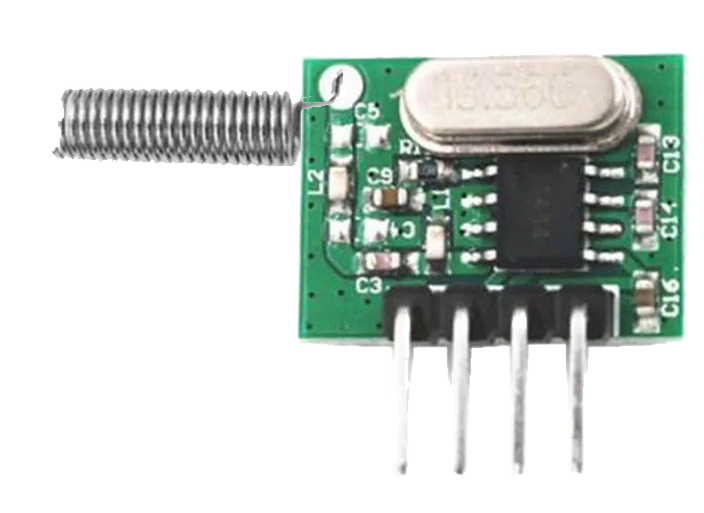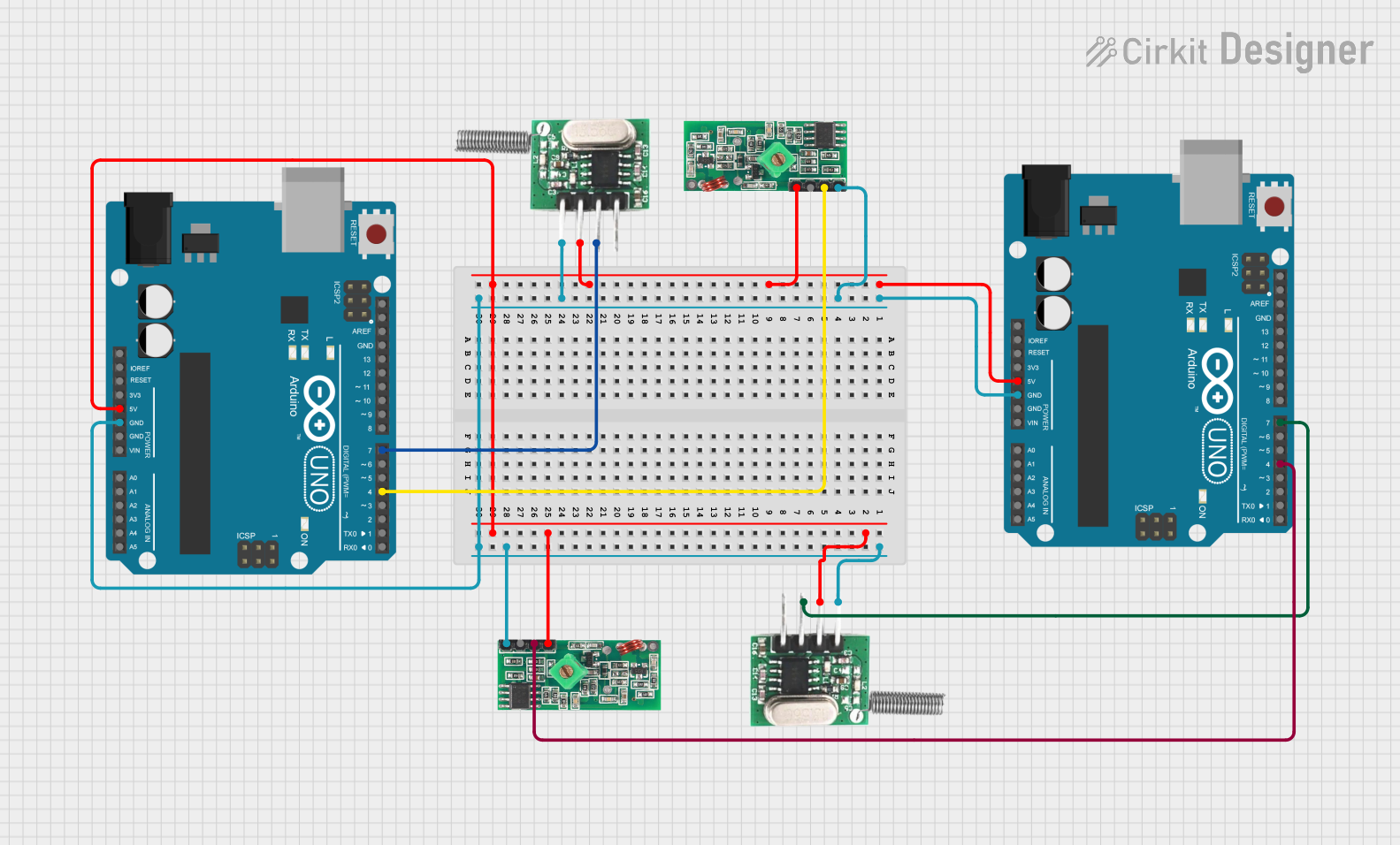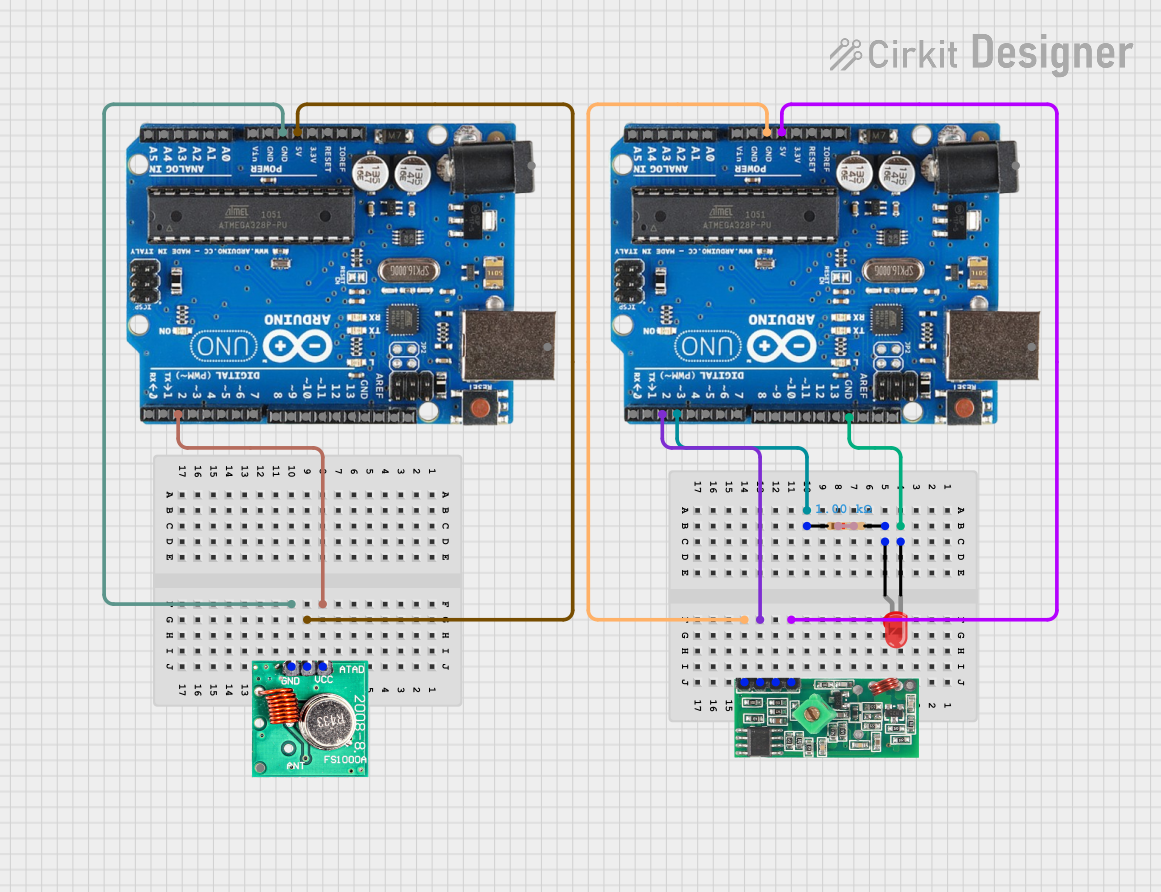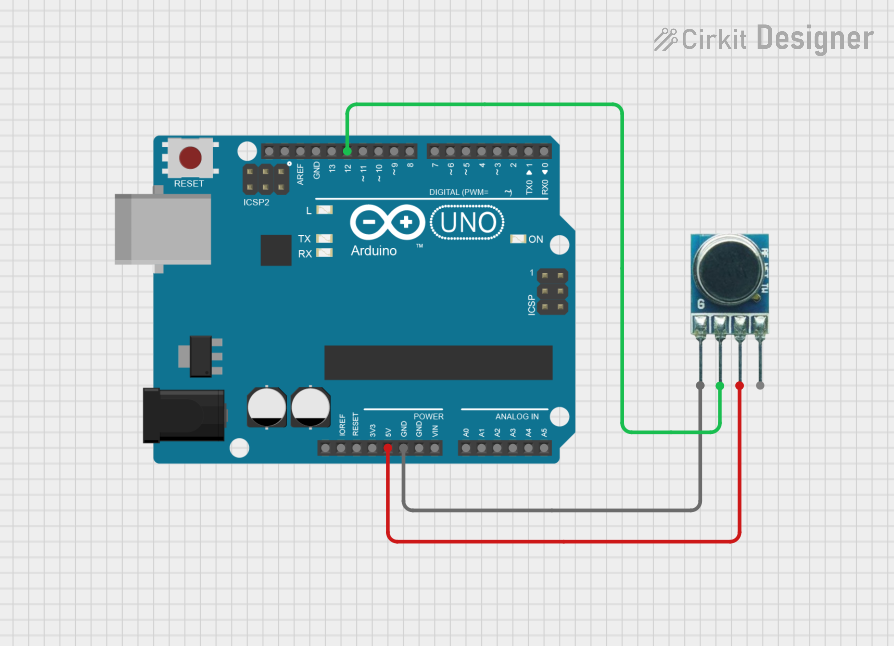
How to Use RF 433 MHz Transmitter: Examples, Pinouts, and Specs

 Design with RF 433 MHz Transmitter in Cirkit Designer
Design with RF 433 MHz Transmitter in Cirkit DesignerIntroduction
The RF 433 MHz Transmitter is a wireless communication component that operates at a radio frequency of 433 megahertz. It is widely used in remote control systems, home automation, wireless sensor networks, and various DIY projects. The transmitter is capable of sending data over short to medium distances without the need for a direct line of sight, making it a versatile choice for many wireless applications.
Explore Projects Built with RF 433 MHz Transmitter

 Open Project in Cirkit Designer
Open Project in Cirkit Designer
 Open Project in Cirkit Designer
Open Project in Cirkit Designer
 Open Project in Cirkit Designer
Open Project in Cirkit Designer
 Open Project in Cirkit Designer
Open Project in Cirkit DesignerExplore Projects Built with RF 433 MHz Transmitter

 Open Project in Cirkit Designer
Open Project in Cirkit Designer
 Open Project in Cirkit Designer
Open Project in Cirkit Designer
 Open Project in Cirkit Designer
Open Project in Cirkit Designer
 Open Project in Cirkit Designer
Open Project in Cirkit DesignerTechnical Specifications
Key Technical Details
- Frequency: 433 MHz
- Modulation: ASK (Amplitude Shift Keying)
- Supply Voltage (Vcc): 3V to 12V
- Operating Current: 9 mA (typical at 5V)
- Output Power: +10 dBm to +13 dBm (depending on supply voltage)
- Range: 20-200 meters (environment dependent)
Pin Configuration and Descriptions
| Pin Number | Name | Description |
|---|---|---|
| 1 | Vcc | Power supply input (3V to 12V) |
| 2 | GND | Ground connection |
| 3 | DATA | Data input for modulation |
| 4 | ANT | Antenna connection (typically a 17cm wire for 433MHz) |
Usage Instructions
How to Use the Component in a Circuit
- Power Supply: Connect the Vcc pin to a power source within the specified range (3V to 12V). Ensure that the power supply is stable.
- Ground: Connect the GND pin to the ground of your power supply and the ground of your data source.
- Data Input: Connect the DATA pin to the data output of your encoding device or microcontroller.
- Antenna: Attach a 17cm wire to the ANT pin to act as an antenna. The length of the wire is crucial for optimal transmission range and efficiency.
Important Considerations and Best Practices
- Antenna Length: For best performance, use a quarter-wave monopole antenna, which is approximately 17cm for the 433 MHz frequency.
- Power Supply: Higher supply voltages within the specified range will result in higher transmission power and range.
- Data Rate: Keep the data rate low to ensure reliable transmission over longer distances.
- Interference: Be aware of potential interference from other devices operating at 433 MHz.
- Regulations: Ensure compliance with local regulations regarding the use of RF transmitters.
Example Arduino UNO Connection and Code
#include <RH_ASK.h>
#include <SPI.h> // Not required, but included for compatibility
// Create ASK object
RH_ASK rf_driver;
void setup()
{
Serial.begin(9600); // Start serial communication
if (!rf_driver.init())
Serial.println("init failed");
}
void loop()
{
const char *msg = "Hello World";
rf_driver.send((uint8_t *)msg, strlen(msg));
rf_driver.waitPacketSent();
delay(1000); // Wait for a second before next transmission
}
Code Comments
RH_ASK rf_driver;creates an instance of theRH_ASKclass for handling the RF communication.rf_driver.init()initializes the RF driver and checks if the setup is successful.rf_driver.send((uint8_t *)msg, strlen(msg));sends the message.rf_driver.waitPacketSent();waits until the entire message has been sent.delay(1000);pauses the loop for one second before sending the next message.
Troubleshooting and FAQs
Common Issues
- No Signal: Ensure the antenna is properly connected and is the correct length.
- Weak Signal: Increase the power supply voltage within the allowed range or reduce the data rate.
- Interference: Change the location or environment to minimize interference from other devices.
Solutions and Tips
- Antenna Tuning: Adjust the length of the antenna for optimal performance.
- Power Supply: Use a regulated power supply to maintain a stable voltage.
- Data Encoding: Use proper encoding techniques to improve signal integrity.
FAQs
Q: Can I use multiple transmitters in the same area? A: Yes, but ensure they are not transmitting simultaneously to avoid interference.
Q: What is the maximum range I can achieve? A: The range depends on the supply voltage, antenna, environment, and data rate. Under ideal conditions, it can reach up to 200 meters.
Q: Is it legal to use this transmitter? A: It depends on local regulations. Always check your local laws regarding the use of RF transmitters.
Q: Can I connect this transmitter directly to an Arduino? A: Yes, you can connect the DATA pin to an Arduino digital pin and use a library like RadioHead for communication.